More about Thimbles





Magdalena and William Isbister.
Identifying a damaged thimble may be easy. The crack, chip or hole may be clearly visible, however, cracks chips and holes may be difficult to see because either they are very small or they have been deliberately ‘disguised’. What to do with a damaged thimble may also be a problem, should one throw it away or keep it, should one buy it or not? How can one recognise a damaged thimble? In this ‘visual guide’ we will try to answer these questions.
Both Zalkin (1) and Holmes (2) advise against buying damaged thimbles. Holmes wrote ‘silver thimbles with holes in them, for instance, should be avoided, and so should thimbles which have been repaired.’ Zalkin said that ‘unless the item is extremely rare, do not buy anything in less than very good condition. Repaired pieces should sell for sixty to eighty percent less than pieces in excellent condition’.
Thimble collecting is a very personal hobby and clearly ones own thimble collecting goals must determine ones policy towards buying damaged thimbles. If a thimble is old and/or rare you may not be able to get a perfect version and it would thus be reasonable to buy it, however, if you were buying for investment then may be you should not buy that particular thimble. As thimbles become scarcer and scarcer on the open market it may become more and more difficult to find perfect specimens and, increasingly, one may have to accept some degree of damage. Some argue that a little wear, the odd ding and a hole or two indicate a full and busy life for the thimble and some are prepared to accept an old work horse thimble into their collection. Clearly ‘to buy or not to buy’ is a very personal matter and the Holmes - Zalkin advice can only be used as a general guide. If we like a thimble we may buy it, holes and all, but we would not expect to pay the full price for a holy one!
Recognising damage/repairs
Examine the thimble in a good light with a 10x magnifying glass (loupe) both outside and inside, often signs of damage or a repair are only visible on the inside of the thimble. Hold the thimble to the light to look for holes or better place the thimble over the bulb of a ‘pen torch’.
Medieval thimbles
Acceptable damage in an old thimble depends upon the rarity of the thimble itself.


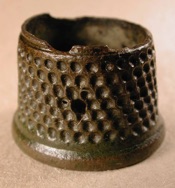
Fig 1 Fig 2 Fig 3
The thimble shown in figure 1 is a rare six-sided thimble and the rim damage is acceptable in our opinion. The damage shown in figures 2 and 3 is not acceptable, however, because these thimbles, in good condition, are in plentiful supply. It is important to differentiate damage from wear and tear from defects that arise as a result of the process of manufacture. Early deep drawn ‘beehive’ thimbles often seem to have rim defects where the metal has become pleated as a result of being hammered into a mould (fig 4). Some ‘beehive’ thimbles have an inverted ‘V’ defect in the rim and this is thought to have been used in the manufacture of the thimble to stabilise it on a lathe (fig 5).

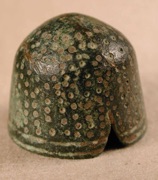
Fig 4 Fig 5
The thimble in figure 6 had a steel top which has nearly completely rusted away and a small crack in the rim – these thimbles are not too common and this one, in our opinion, is marginally acceptable.
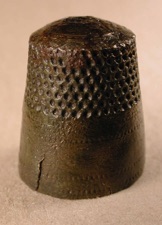
Fig 6
Porcelain
Clearly because of the fragile nature of porcelain many older thimbles may be damaged or even repaired. It is important to differentiate the crazing or superficial cracking of a glaze (figs 7, 8) from real damage (fig 9). The former seems to be acceptable to most collectors.
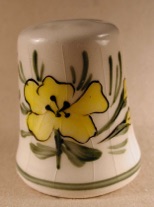
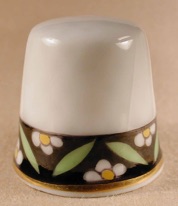
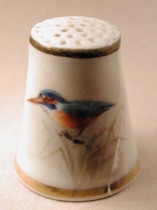
Fig 7 Fig 8 Fig 9
Restoration of the paintwork and gilding may be more difficult to spot.
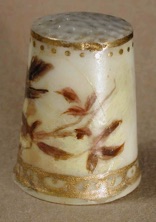
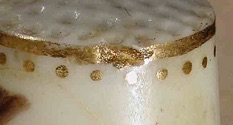
Fig 10 Fig 11
This thimble (fig 10, 11) looks to be in good condition, apart from the gilding problem, and examination of the inside does not reveal any defects (fig 12). When the thimble is transilluminated, however, a large crack may be seen (fig 13) which is not visible under normal illumination. The rather ‘matt’ appearance of the interior of the thimble is a clue to the fact that ‘something’ has been done to this thimble. In fact, a large piece of the thimble had broken and the porcelain was restored along with the hand painting of the flowers and re gilding of the damaged area
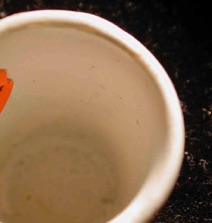
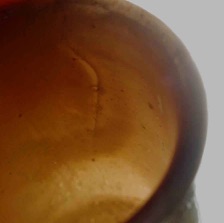
Fig 12 Fig 13
Metal
This thimble is very rare and the small defects in the filigree are acceptable (fig 14). We think that the thimble in figure 15, although an 18th century filigree thimble, is so damaged that it should be rejected.
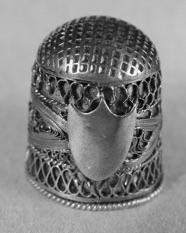
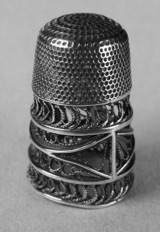
Fig 14 Fig 15
Two part thimbles made in the 17th century (fig 16) often have defects in the solder and seams may come apart. These ‘cracks’ can easily be re-soldered although ‘purists’ may feel that the thimbles should be left ‘as found’. The thimble if figure 17 has, in addition to the split in the seam, a small repair to the left of the split.
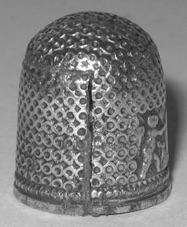
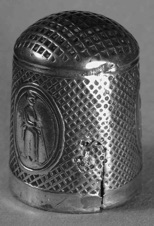
Fig 16 Fig 17
The rim of the thimble in figure 18 is clearly ‘not right’ and when the interior of the thimble is examined a small patch repair can be seen (fig 19 -1).
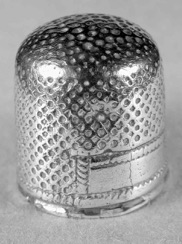
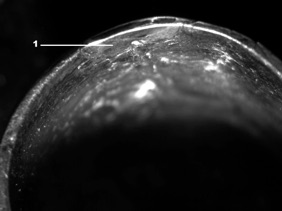
Fig 18 Fig 19
The steel tops from early English silver thimbles rust away in the ground and only bits of the steel remain (fig 20). Sometimes the tops of these thimbles may appear so clean that the only abnormality seen is the lack of dimpling (fig 21).
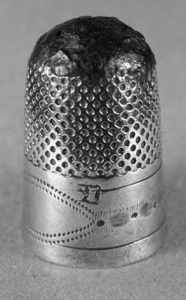
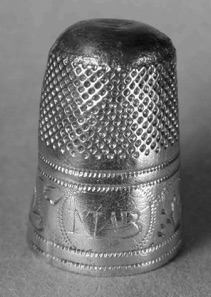
Fig 20 Fig 21
The old 17th century thimble in figure 22 is rather rare and a new top was made because when it was dug up no top was found with it. In contrast, the modern reproduction of the thimble (note hallmark) shows how the top should have looked (fig 23).

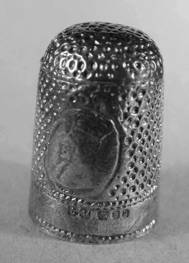
Fig 22 Fig 23
Another example of lost solder can be seen in the gold thimble shown in figures 24 and 25.
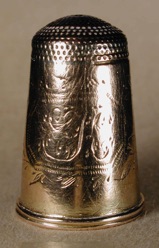
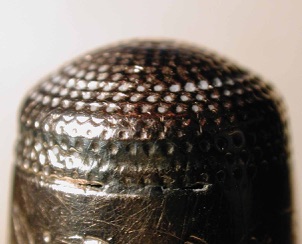
Fig 24 Fig 25
A small slit incurred during the manufacture of this gold thimble (fig 26) is quite acceptable but the dented top of the silver thimble in figure 27 is not!
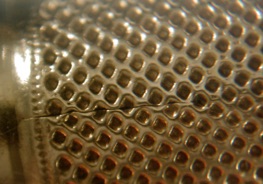
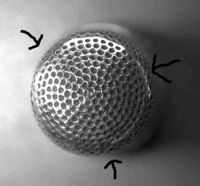
Fig 26 Fig 27
It is our opinion that the thimbles shown in figures 28-30 should be discarded because of the rather big holes. The holes in the thimble tops are identified by inside illumination.

Fig 28
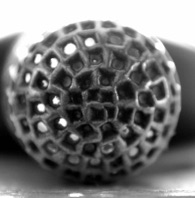
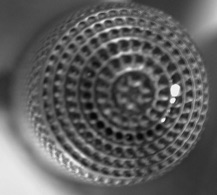
Fig 29 Fig 30
Damage and thus holes may be caused by punching a maker’s mark (fig 31) or engraving a letter (fig 32) and may be acceptable depending upon the rarity of the thimble in question.
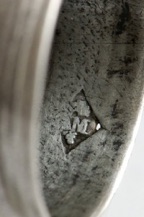
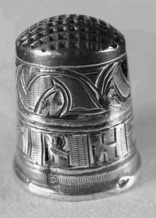
Fig 31 Fig 32
Thimble tops must be examined very carefully for holes (fig 33 -1) and repaired holes (lack of symmetrical dimpling) which may be difficult to identify on superficial examination (fig 34 -1)
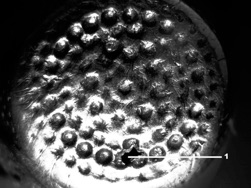
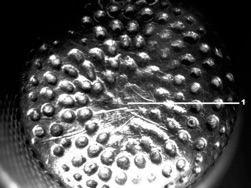
Fig 33 Fig 34
The top of the thimble shown in figure 35 is clearly new – the dimpling is of a different size and there is a thick band of solder between the top and the sides of the thimble.
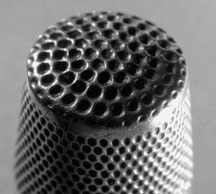
Fig 35
The some of the holes in the top of this thimble (fig 36) are filled with old silver polish and when the thimble is held up to the light no holes are visible. Closer examination reveals the presence of a ‘false top’ (fig 37), an old repair to enable a loved thimble to be used for some time longer.
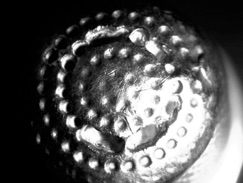

Fig 36 Fig 37
A small irregularity in the side dimpling of this ‘castle thimble’ (fig 38) is, in reality, a repair and some of the dimples have not been replaced in the repair solder (fig 39 -1).
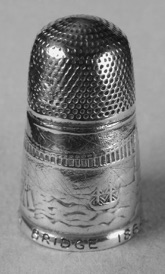
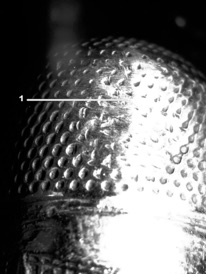
Fig 38 Fig 39
The third and top band of decoration of this thimble (fig 40) had been worn through in many places and was repaired by its owner with a simple applied band. This simple measure prolonged the life of the thimble considerably.
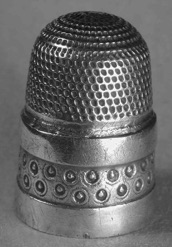
Fig 40
The rim of this thimble has been repaired with a ‘blob’ of solder (fig 41). Inside examination of the rim of this thimble shows repaired damage (fig 42).
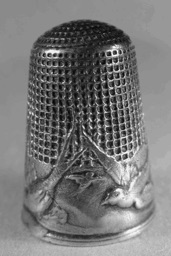
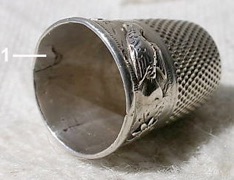
Fig 41 Fig 42
A band of dimples near the top of this thimble (fig 43 -1) looks a little irregular and close examination of the interior of the thimble demonstrates the repair (fig 44 -1).
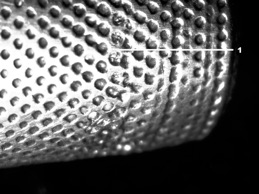
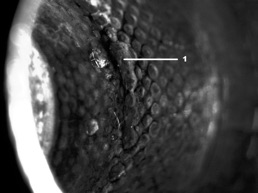
Fig 43 Fig 44
Close inspection is necessary to detect the repair in this thimble (fig 45 –1). The marked dimples are fresher and larger than the surrounding dimples and indicate the repair.
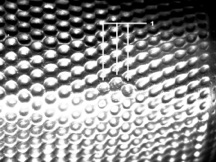
Fig 45
A small split has been repaired in this thimble (fig 46 –1) and remains of the crack may still be seen at the rim (fig 46 –2).
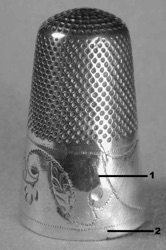
Fig 46
Enamel thimbles
Enamel damage may be quite obvious (fig 47) but often it may blend in with the design (fig 48). Small defects in the enamel are dwarfed by the poorly fitting ‘recent’ top in the thimble shown in figure 49.
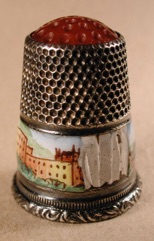
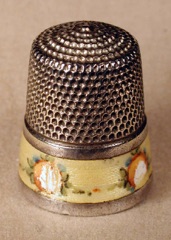
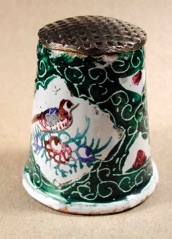
Fig 47 Fig 48 Fig 49
Traces of enamel remain on the belt of this gold thimble (fig 50).
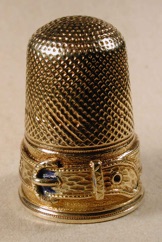
Fig 50
Other
Occasionally a defect may be unseen unless the thimble is examined in different lights (fig 51-2). There is a small chip in the tortoiseshell above the rim and below the ‘C’ in ‘Piercy’s’.
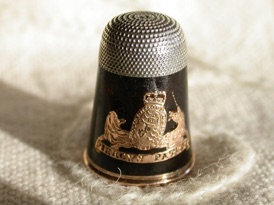
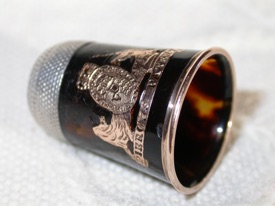
Fig 51 Fig 52
This thimble has chipped stones (fig 53 –1) and the glue at the site of repair has not been removed fully (fig 53 –2) and is a telltale sign of mischief.
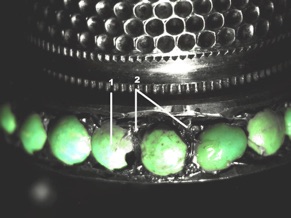
Fig 53
Postal damage
Some thimbles are sent by post and leave in perfect condition. Sadly they may not be very well packed and varying degrees of damage may occur. Simple squashing (fig 54) can be remedied but care must be taken with old thimbles because they can be very brittle. More serious damage (fig 55), even in a very rare thimble should be rejected because repair will be very hazardous indeed. Some thimbles are impossible to repair (fig 56)!
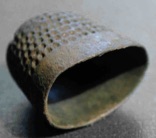
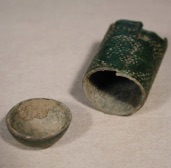
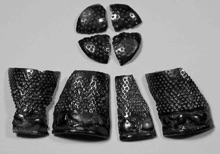
Fig 54 Fig 55 Fig 56
Damaged thimbles are very often worth keeping, we feel, despite advice to the contrary but in the end the collector must decide whether or not he or she wants to include the thimble in the collection. Damaged thimbles should not be as expensive as perfect pieces but as the rarity of the thimble increases the gap between the damaged price and the perfect price diminishes. Collectors must fashion their own collecting rules and then live with them! They might also insist on having thimbles sent in boxes through the post because the postal rollers do quite a lot of harm to an unprotected thimble!
References
1. Zalkin E. Zalkin’s Handbook of Thimbles & Sewing Implements, 1st edn. Willow Grove: Warman Publishing Co., Inc., 1985.
-
2. Holmes EF. A history of thimbles. London: Cornwall Books, 1985.
Holmes:'Collecting Thimbles' pp. 236
Addendum - thimble repairs
We recently found a bill for silver repairs which had been undertaken in the 18th century by the goldsmith, Anthony Hindley of London. He had charged the Hon.T. Lyon of Durham the princely sum of one shilling for the thimble repair! Clearly even these times it was thought to be worthwhile to repair silver thimbles!
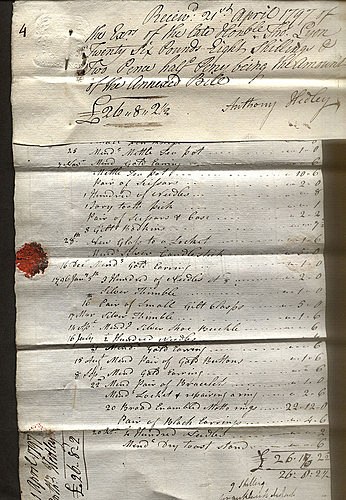
Researched and published in 2002/11
Copyright@2011. All Rights Reserved
Magdalena and William Isbister, Moosbach, Germany
damaged thimbles
Navigation
